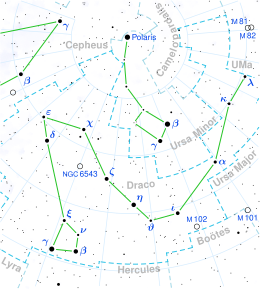| Observation data Epoch J2000 Equinox J2000 | |
|---|---|
| Constellation | Draco |
| Right ascension | 16h 01m 53.34636s[1] |
| Declination | +58° 33′ 54.9056″[1] |
| Apparent magnitude (V) | 4.1190[1] |
| Characteristics | |
| Spectral type | F9 V[2] or F8IV-V[3][4] |
| U−B color index | +0.11[5] |
| B−V color index | +0.528±0.013[6] |
| Astrometry | |
| Radial velocity (Rv) | −8.23±0.20[6] km/s |
| Proper motion (μ) | RA: −319.51[1] mas/yr Dec.: 334.97[1] mas/yr |
| Parallax (π) | 47.54 ± 0.12 mas[1] |
| Distance | 68.6 ± 0.2 ly (21.03 ± 0.05 pc) |
| Absolute magnitude (MV) | 2.39[7] |
| Orbit[8] | |
| Period (P) | 3.0708216±0.0000069 d |
| Semi-major axis (a) | ~0.048 AU (10 R☉)[9] |
| Eccentricity (e) | 0.039±0.012 |
| Periastron epoch (T) | 5,971.98±0.13 |
| Argument of periastron (ω) (secondary) | 63±15° |
| Semi-amplitude (K1) (primary) | 25.10±0.31 km/s |
| Semi-amplitude (K2) (secondary) | 66.0±2.2 km/s |
| Details[7] | |
| A | |
| Mass | 1.53 M☉[7] 1.2±0.1 M☉[8] 1.18[3] M☉ |
| Radius | 2.83+0.12 −0.05[10] R☉ |
| Luminosity | 9.998±0.137[10] L☉ |
| Surface gravity (log g) | 3.79 cgs |
| Temperature | 6,105+53 −129[10] K |
| Metallicity [Fe/H] | +0.19 dex |
| Rotational velocity (v sin i) | 30.7 km/s |
| Age | 2.03 Gyr |
| B | |
| Mass | 0.46±0.04 M☉[8] 0.21[3] M☉ |
| Other designations | |
| Database references | |
| SIMBAD | data |
Theta Draconis, a name Latinized from θ Draconis, is a binary star system in the northern circumpolar constellation of Draco. It is faintly visible to the naked eye at night with an apparent visual magnitude of 4.12.[1] Parallax measurements place it at an estimated distance of 68.6 light-years (21.0 parsecs) from the Sun,[1] and it is drifting closer with a radial velocity of −8 km/s.[6] It has a relatively high proper motion, traversing the celestial sphere at the rate of 0.464″ per year.[12] O. J. Eggen included this star as a member of the NGC 1901 supercluster based on its space motion.[13]
The binary nature of this system was discovered by W. W. Campbell in 1899, and the first set of orbital elements was published by H. D. Curtis in 1907.[14] It is a single-lined spectroscopic binary in a close orbit with a period of 3.07 days and an eccentricity (ovalness) of 0.04.[2] The secondary component has been resolved in the infrared H band, allowing an estimation of the mass ratio as 0.38±0.03.[8] Some velocity variation of K1 was observed by M. Mayor and T. Mazeh in 1987, which is suggestive of a tertiary component to the system.[15]
The primary component is a solar-type star[4] that at various times has been assigned stellar classifications of F9 V[2] and F8IV-V.[3] The star is about two billion years old and is spinning with a projected rotational velocity of 31 km/s.[7] It has a high metallicity (heavy element abundances) with around 20%[8] more mass than the Sun and nearly three[10] times the Sun's radius. The star displays no chromospheric emission and may be on or entering the subgiant stage. Because of the close orbit, it could be filling up to 60% of its Roche lobe.[16] The star is radiating ten times the luminosity of the Sun from its photosphere at an effective temperature of 6,105 K.[10]
- ^ a b c d e f g h Cite error: The named reference
LEEUWENwas invoked but never defined (see the help page). - ^ a b c Cite error: The named reference
Abt2009was invoked but never defined (see the help page). - ^ a b c d Cite error: The named reference
Tokovinin_et_al_2006was invoked but never defined (see the help page). - ^ a b Cite error: The named reference
Mazeh_et_al_1992was invoked but never defined (see the help page). - ^ Cite error: The named reference
MERMILLIODwas invoked but never defined (see the help page). - ^ a b c Cite error: The named reference
Anderson_Francis_2012was invoked but never defined (see the help page). - ^ a b c d Cite error: The named reference
Earle2017was invoked but never defined (see the help page). - ^ a b c d e Cite error: The named reference
Mazeh_et_al_2002was invoked but never defined (see the help page). - ^ Cite error: The named reference
Heacox1999was invoked but never defined (see the help page). - ^ a b c d e Cite error: The named reference
GaiaDR2was invoked but never defined (see the help page). - ^ Cite error: The named reference
SIMBADwas invoked but never defined (see the help page). - ^ Cite error: The named reference
Lepine_Shara_2005was invoked but never defined (see the help page). - ^ Cite error: The named reference
eggen1996was invoked but never defined (see the help page). - ^ Cite error: The named reference
Curtis1907was invoked but never defined (see the help page). - ^ Cite error: The named reference
Mayor_Mazeh_1987was invoked but never defined (see the help page). - ^ Cite error: The named reference
Young_Koniges_1977was invoked but never defined (see the help page).
